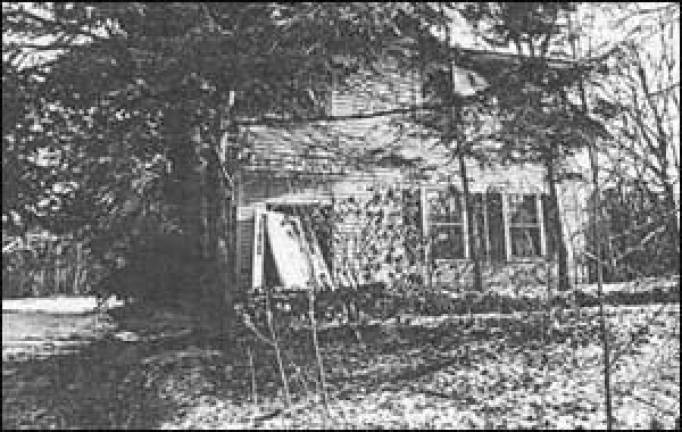How Peter Townsend saved the nation

Contract for West Point’s Great Chain signed in Chester 233 years ago, By Ginny Privitar In these days of intercontinental ballistic missile shields and missile-tracking radar, it’s hard to imagine that the national defense once depended on a simple iron chain. During the Revolutionary War, a patriot named Peter Townsend lived on a three-acre lot not far from the corner of present-day Elm and Main streets in Chester. He was a member of an important family from Oyster Bay, Long Island. The family home, Raynham Hall, is today a museum, and the Townsend family’s accomplishments are documented in the archives of the Townsend Family Society. Townsend owned the Sterling Iron Works near Sterling Pond in Warwick, near the Monroe border. During the Revolutionary War, the fledgling American government needed his help. On Feb. 2, 1778, George Washington’s quartermaster, Hugh Hughes, brought Townsend a contract to manufacture a massive iron chain that would extend across the Hudson River in defense against the British navy. It would protect the fort at West Point and prevent the British from sailing further up the Hudson and connecting with armies from Canada. Two earlier attempts to do this failed. Sterling Iron Works completed the work in about two months. Each link measured approximately two feet across and weighed about 140 pounds. The whole chain weighed some 186 tons. The individual links, swivels, and other attachment pieces were delivered to a foundry in New Windsor overseen by the supervising engineer, Capt. Thomas Machin. There they were joined together, attached to huge logs, and floated down the Hudson to an ideal location at West point where the river was especially narrow and bent sharply. Once in position, the chain was stretched across the Hudson between West Point and Constitution Island on May 1, 1778. So formidable was the chain that the British never attempted to force it. This protected the fort at West Point and prevented the British from joining up with their forces in Canada. Remains of the earthen and stone attachment point can be seen at the Chain Battery on Flirtation Walk at West Point. The other side, on Constitution Island, has a marker. Here also were the cannon emplacements designed to attack ships that slowed to a halt against the chain. The chain later led to the discovery of Benedict Arnold’s treachery, when he wrote the British, claiming a heavy ship could force it. Sterling Iron works produced many armaments for the nation, including the anchors for the USS Constitution, the world’s oldest commissioned warship afloat. Correspondence about the chain and a copy of the contract can be found among the public papers of New York Governor George Clinton. And a portion of the chain can be seen today at Trophy Point, overlooking the river it protected. Peter Townsend was born in Chester in 1736, and died there in 1783 or 1787. During his lifetime, Chester was considered part of the “precinct of Goshen.” Townsend married Hannah Hawhurst in 1761 and inherited the Sterling Mine from his father-in-law, William Hawxhurst. Townsend’s house fell into neglect and was torn down in the 1990s. He and some family members were buried in a plot north of the house. The location is now lost to history the headstones fell on the ground and were eventually covered over. But thanks to the many documents preserved and interpreted by historians, the family’s part in the nation’s early history lives on.
Peter Townsend’s famous relatives
Peter Townsend was also related to Robert Townsend, one of George Washington’s spies in the “Culper Gang” during the American Revolution. Robert, known as “Culper, Jr.,” operated a merchant shipping firm in New York City and was very instrumental in spying on the British.
Yet another Townsend, Solomon, was drawn to the patriots’ cause by several factors, not least of which was the takeover of his family’s Long Island home, Raynham Hall, by British Col. John Simcoe for use as his headquarters. Simcoe was acquainted with Maj. John Andre, and some sources believe Andre was Simcoe’s guest on occasion.
Solomon was captain of a merchant vessel, the Glasgow, which was berthed in London when hostilities caused the end of trade between the states and England. Stranded in London, he made his way to Passy, near Paris. There he met Benjamin Franklin, who had him sign the Oath of Allegiance to the 13 colonies, effectively giving him safe passage back home. Solomon disembarked in Boston. Since he could not return to the family home in Long Island, he made his way to the home of his distant relative, Peter Townsend, whom he called uncle, in Chester. Some believe Solomon learned the iron works business from Peter. Solomon stayed there until he could safely return to Long Island.
Solomon married Peter’s oldest daughter, Ann, in 1782. Peter gave the couple a grandfather clock, which stands today in Raynham Hall.
Solomon Townsend bought land in Orange County and established the Augusta Forge in Tuxedo Park. He later lived in New York City and represented the city in the New York State Legislature.
For more information on the Townsend family visit www.raynhamhallmuseum.org or www.townsendsociety.org.
Sources: Orange County Historical Society, Chester Historical Society, Raynham Hall Museum, and the Townsend Society.